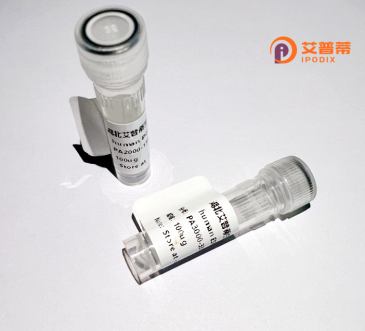
| 纯度 | >90%SDS-PAGE. |
| 种属 | Human |
| 靶点 | RNF146 |
| Uniprot No | Q9NTX7 |
| 内毒素 | < 0.01EU/μg |
| 表达宿主 | E.coli |
| 表达区间 | 1-359 aa |
| 活性数据 | MMAGCGEIDH SINMLPTNRK ANESCSNTAP SLTVPECAIC LQTCVHPVSL PCKHVFCYLC VKGASWLGKR CALCRQEIPE DFLDKPTLLS PEELKAASRG NGEYAWYYEG RNGWWQYDER TSRELEDAFS KGKKNTEMLI AGFLYVADLE NMVQYRRNEH GRRRKIKRDI IDIPKKGVAG LRLDCDANTV NLARESSADG ADSVSAQSGA SVQPLVSSVR PLTSVDGQLT SPATPSPDAS TSLEDSFAHL QLSGDNTAER SHRGEGEEDH ESPSSGRVPA PDTSIEETES DASSDSEDVS AVVAQHSLTQ QRLLVSNANQ TVPDRSDRSG TDRSVAGGGT VSVSVRSRRP DGQCTVTEV |
| 分子量 | 38.9 kDa |
| 蛋白标签 | His tag N-Terminus |
| 缓冲液 | PBS, pH7.4, containing 0.01% SKL, 1mM DTT, 5% Trehalose and Proclin300. |
| 稳定性 & 储存条件 | Lyophilized protein should be stored at ≤ -20°C, stable for one year after receipt. Reconstituted protein solution can be stored at 2-8°C for 2-7 days. Aliquots of reconstituted samples are stable at ≤ -20°C for 3 months. |
| 复溶 | Always centrifuge tubes before opening.Do not mix by vortex or pipetting. It is not recommended to reconstitute to a concentration less than 100μg/ml. Dissolve the lyophilized protein in distilled water. Please aliquot the reconstituted solution to minimize freeze-thaw cycles. |
以下是关于重组人RNF146蛋白的3篇参考文献概览:
---
1. **文献名称**: *RNF146 is a poly(ADP-ribose)-directed E3 ligase that regulates axin degradation and Wnt signaling*
**作者**: Zhang Y.H., et al.
**摘要**: 该研究解析了RNF146作为E3泛素连接酶,通过识别PARylated(聚ADP-核糖化)底物(如Axin),促进其泛素化降解,从而激活Wnt/β-catenin信号通路的分子机制。实验中使用了重组RNF146蛋白验证其与PAR链及Axin的相互作用。
2. **文献名称**: *Recognition of the iso-ADP-ribose moiety in poly(ADP-ribose) by RNF146 protein*
**作者**: Wang Z., et al.
**摘要**: 报道了RNF146通过N端的PBZ结构域特异性识别PAR链中的iso-ADP-ribose结构,并揭示其依赖PARylation的底物泛素化机制。通过重组蛋白体外实验证实了RNF146与PAR的亲和力及其对底物选择性的调控。
3. **文献名称**: *Structural basis for RNF146 function in Parkin-dependent mitophagy*
**作者**: Zhou J., et al.
**摘要**: 利用重组RNF146蛋白及冷冻电镜技术,揭示了RNF146在Parkin介导的线粒体自噬(mitophagy)中,通过结合磷酸化泛素链并招募自噬受体蛋白的分子结构基础,阐明了其协调泛素信号与自噬过程的作用。
---
以上研究均涉及重组RNF146蛋白在功能机制验证、结构解析或信号通路研究中的关键应用。
RNF146 (Ring Finger Protein 146) is a ubiquitously expressed E3 ubiquitin ligase belonging to the RING finger family, characterized by a conserved C3HC4-type RING domain critical for its catalytic activity. It plays a pivotal role in regulating cellular stress responses, particularly through its interaction with poly(ADP-ribose) (PAR)-modified proteins. RNF146 recognizes PARylated substrates via its N-terminal PAR-binding domain, promoting their ubiquitylation and subsequent proteasomal degradation. This mechanism is essential in DNA damage repair, where RNF146 facilitates the removal of PARylated proteins at sites of DNA breaks, ensuring genomic stability. It also modulates Wnt/β-catenin signaling by targeting axin for degradation, influencing cell proliferation and differentiation.
Dysregulation of RNF146 has been linked to various pathologies, including cancer, neurodegenerative diseases, and metabolic disorders. Overexpression of RNF146 is observed in certain cancers, correlating with poor prognosis, while its loss exacerbates neuronal damage in conditions like Parkinson’s disease. Recombinant human RNF146 protein, typically produced in bacterial or mammalian expression systems, is widely used to study its biochemical functions, substrate interactions, and therapeutic potential. Structural studies of recombinant RNF146 have elucidated its PAR-binding specificity and E3 ligase mechanisms, offering insights for drug development targeting PAR-dependent pathways. Its dual role in stress adaptation and signaling underscores its importance as a molecular mediator in health and disease.
×